
|
Ezio, my friend! How may I be of service? This article is in desperate need of a revamp. Please improve it in any way necessary in order for it to achieve a higher standard of quality in accordance with our Manual of Style. |
- "For centuries we have focused on the trappings of power: the titles of nobility, the offices of Church and State. Caught in the very lie we crafted to shepherd the masses... In the wake of revolution, the Order will adapt. They will retreat to the shadows and we will, at last, be the secret masters that we were meant to be."
- ―François-Thomas Germain to Élise de la Serre, regarding the Templars' agenda, 1794.[src]
The Parisian Rite of the Templar Order is the Rite of the Templar Order operating in France.
The Rite operated openly during the Crusades until it was forced underground. During the Rennaissance, it collaborated with the Roman Rite, as they fought against both the Parisian Brotherhood and the Italian Brotherhood while manipulating King Louis XII of France.
The Rite notably managed to maintain for several years a truce with the French Brotherhood of Assassins, negotiated between the Grand Master François de la Serre and the Mentor Mirabeau, despite opposition to the idea among members of both factions.
History
Middle Age
Public foundation
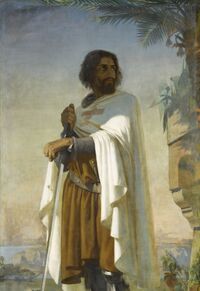
Hugues de Payen, first public Grand Master
Before the 12th century, a group known as the Order of the Ancients tried to control the world from behind the scenes since the 14th century BCE. Their main goal was to create a New World Order using Pieces of Eden, ancient artifacts with strange power created by the Isu, the First Civilization. In 1119, a member of this Order, Hugues de Payens, decided to make the Order public, presenting it as a monastic and knightly order which would protect the pilgrims and the Jerusalem Temple. De Payen became the first public Grand Master of the Knights Templar.[1] In 1129, the Order of the Knights Templar was formed in Troyes, which later became a Templar base.[2] The abbot Bernard de Clairvaux, who was a member of the Order, wrote the Latin Rule, the Code of the Templar Order.[1]
Serving first as protectors, the Templars became a military force used by the Latin States during the crusades in the Holy Land. All over Europe, the Order possessed fortresses from which to train their recruits. One of these fortresses, the Temple, was their headquarters in Paris.[3] Many French Templars went to the Holy Land to serve in the crusades. During the Third Crusade, the Lévesque family joined the Templar Order.[4][3]
In 1191, the Grand Master Robert de Sablé tried to conquer all the Holy Land with an Apple of Eden, one the Pieces of Eden that could control minds. He allied with members of the Levantine Rite of the Templar Order but also with the leader of the sworn enemy of the Templars, the Mentor of the Levantine Brotherhood of Assassins, Al Mualim. Wanting the Apple for himself, the Mentor betrayed the Templars and sent his Assassins to recover it under Solomon's Temple. De Sablé and his troops attacked the stronghold of Masyaf, but were forced to retreat after the Assassins activated a trap that killed many soldiers.[5]
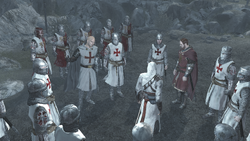
Robert de Sablé and his men at Arsuf confronting Altaïr
Despite lacking the Apple, de Sablé and his men tried to proceed with their plan without it, instead creating their own army from marginalized peoples in the city or otherwise forcing their compliance with drugs. They also controlled the cities of Damascus, Acre and Jerusalem, and tried to impeach the interference of European kings by plotting to kill Richard I of England. All their plans were foiled by the Master Assassin Altaïr Ibn-La'Ahad, who killed the eight major Templars in the Levant. Before the Battle of Arsuf, de Sablé attempted to unify the Crusaders and the Saracens against the Assassins as Altaïr killed Templars on both sides, but the Assassin revealed the Grand Master's plan. The king of England decided that the question would be settled in a duel between Altaïr and de Sablé. The Assassin mortally wounded the Templar, who revealed to Altaïr with his last breath that Al Mualim worked with the Templars and would betray Altaïr.[5]
After the death of de Sablé, another French Templar, Armand Bouchart took command of the Order from Cyprus. He was fought by Altaïr, who by then had become Mentor of the Levantine Assassins. Altaïr allied with Maria Thorpe, an English Templar who was loyal to de Sablé but was betrayed by Bouchart and the Templars who fled Acre. In 1193 after a fight in the Templar Archive under the Limassol Castle, Bouchart was killed by Altaïr.[6]
De Molay's sacrifice

De Molay burned at the stake
By 1307, the French King Philip IV was manipulated by the Mentor of the Parisian Brotherhood, Guillaume de Nogaret, into accusing the Templars of heresy, forcing Pope Clement V to disband them. The Templars were branded as heretics, and their stronghold in Paris was attacked by the King's forces with the help of the Assassins disguised as Flemish mercenaries. During the attack, Thomas de Carneillon tried to steal the Codex Pater Intellectus and a Sword of Eden but was stopped by a Templar Knight, who hid the two artifacts in the vault of Grand Master Jacques de Molay before being killed by the Assassin.[3]
When de Molay was arrested, he smuggled the Heart with him into the Château de Chinon, where he was imprisoned. There, he carved a hole into the dungeon's wall and placed the artifact inside, before covering up the hiding place with plaster. De Molay also left drawings that hinted at the Heart's location, as well as a quote in Latin, "If the heart is strong, it will not break," indicating how the Heart was to be used.[7] De Molay allowed himself to be burned at the stake to fool his enemies into believing the Templars had been destroyed. However, Jacques passed his knowledge of the Ancients to nine of his subordinates, whom he sent into the world to continue his work, so the Templars would fade from public awareness and operate underground.[8][1]
In 1312, the Templar Order was officially dissolved by Pope Clement in his papal bull, Vox in excelso, and all of its assets were gifted to the Knights Hospitalier.[3]
Hundred Years' War
During the 14th century, the influence of the Order decreased in Europe, but they remained active behind the scene. In the Hundred Years' War, the Templars sought to help the kings of England reclaim the crown of France. The Order counted amongst their number members of the ruling class, the regent of France John, Duke of Bedford, Philip III of Burgundy, Georges de la Trémoille, and John II of Alençon, who was secretly a novice French Assassin. The Templars controlled the major part of France, as the heir of the House of Valois, Charles VII of France, ruled only on the south of France in Bourges.[7]
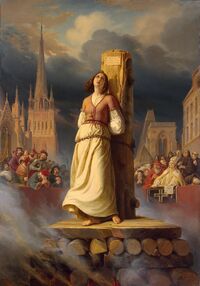
"Jeanne d'Arc" burned at the stake
The French king was supported by the Assassins and help by Jeanne d'Arc, a young peasant who recovered the de Molay's Sword of Eden and the Heart. As Jeanne won many battles with the French Army, the Templars captured her and returned the Sword of Eden to de Molay's vault. They decided to judge the woman for witchery and sent her to Rouen. There, in 1431, the Templars Pierre Cauchon and Jean d'Estivet condemned her to burn at the stake. Before her execution, Jeanne was secretly saved by a handful of Assassins who switched her with Fleur, Jeanne's protégé. Unfortunately, the deception was all too successful: although it convinced the Templars that Jeanne had died, it disillusioned John of Alençon in the Assassins' cause. Believing that the Brotherhood had abandoned Jeanne, Jeanne's "death" was the catalyst for his renouncing the Brotherhood and joining the Templars.[7]
Renaissance
During the Renaissance, once the Grand Master Rodrigo Borgia of the Roman Rite was elected as Pope Alexander VI, the Borgia family allied themselves with King Louis XII of France to ensure the support of the French army, as well as the loyalty from the French Templar, Octavian de Valois.[9] Louis moreover left the kingdom under the charge of his courtiers, who were secretly allied with the Templars. The Templars also battled a group of Italian Assassins in Paris, sent by their Mentor, Ezio Auditore da Firenze.[10]
Under Templar's influence after the fall of the Borgia, Louis' advisors persuaded him that the Assassins were behind Marseille's threats of secession from France; as such, he ordered all Assassins banished from the city. The Assassins stopped his army's efforts and later the advisors were then dispatched by the Assassins. After the failed purge of the Assassins there, the Templars lost their influence in Marseille to the Assassins.[1]

The Viper, with Giovanni Borgia behind him
Around 1527, The Viper traveled to Basel, and discovered the Assassins' intentions to locate the second half of the mysterious tome known only as "the Book." The Viper carried a letter containing detailed descriptions of Giovanni Borgia and Maria Amiel back to the Templar base in Troyes. Later that year, the Assassin Giovanni, along with Maria, visited Troyes, though they was cautious about entering the Templar-controlled city. The following day, the Viper was identified by the Troyes Cathedral. The Viper then came over to Maria and began speaking to her, whispering in her ear, but he was quickly approached from behind and assassinated by Giovanni. Afterward several enraged Templars pursued the pair as they left the town. In a nearby wood, the "Minions of the Cross", ambushed them but Giovanni was able to drive them off; and afterward, the two were able to avoid further trouble.[2]
Age of Enlightenment

Reginald Birch's chateau near Troyes
The Grand Master of the British Rite, Reginald Birch, took over the Droupt-Saint-Basle chateau near Troyes in 1740, using it as a base of operations. He lived there with his protégé Haytham Kenway, who trained on the grounds of the chateau in the ways of the Templars, eventually inducting him in 1744. When it became clear that Haytham was a skilled killer. Birch then sent Haytham on several missions for the Order.[11]
By 1747, the French Empire and the Ottoman Empire were secretly influenced by the Assassins, prompting the Portuguese Templar Manuel Pinto da Fonseca to negotiate with Reginald Birch for aid. In 1747, Magdelaine Lévesque recognized Madeleine de L'Isle's handling of her father's business, integration into the upper echelons of New Orleans society, and her discovery of the Templar Order. Because of this, Lévesque sent a letter to de L'Isle where she offered her a position within their ranks, and tasked her with finding something of immense value beneath the ancient Mayan structures in the Yucatán Peninsula in Mexico.[4]
In 1753, Birch gave Haytham an assignment, to kidnap Lucio Albertine, a Corsican scholar who could decode the journal. Haytham captured him, but he expressed concern over Lucio and his mother Monica's treatment after coming to Birch's chateau and seeing them chained in the cellar. Birch gave him his word that they would be released safely once their work was done.[11]
Haytham attacked the chateau in 1757, along with his half-sister Jennifer Scott and Jim Holden after having discovered that Birch had been behind the death of his father. During the attack, Birch and his henchmen were killed, and Haytham would reside there with Jennifer and Holden for a brief while.[11]
On 20 November 1759, during the Seven Years' War in the Battle of Quiberon Bay in the Bay of Biscay. The Morrigan, commanded by Colonial Templars Shay Cormac and Christopher Gist, fought against the French fleet in a naval engagement. This French fleet was headed by the Formidable, which sought to launch a direct strike at the United Kingdom through Scotland. Despite the assistance of fireships, the Formidable was sunk by the Morrigan and the rest of the English fleet fought off the remains of the French fleet, forcing them to abandon their plans in invading the United Kingdom.[4]
French Revolution
New leadership
During 1768, François married fellow Templar Julie de la Serre and acquired an estate in Versailles, as well as a smaller residence in Paris. Rising to the position of Grand Master, François had a daughter, Élise, with Julie in 1768. At some point, he became a close confidant of King Louis XVI and the Assassin Mentor, Honoré Gabriel Riqueti, Comte de Mirabeau.[3]
A Parisian Templar came into conflict with Charles Dorian while he was on a mission, but was killed by Pierre Bellec who came to Charles aid.[3]
In 1774, during the spring, the de la Serre family was visited by the British Templar family, the Carrolls, due to their concerns of François' plans for keeping France in order. Mrs. Carroll told Julie about the London Templar's concerns for the intentions of François wherein they argued about change and loyalties. Julie assured her that she would abide their principles and would not allow her husband to be swayed by his advisers.[12]
Julie and Élise during the assassination attempt
In 1776, Julie and Élise went shopping in Paris. Afterward, they were stalked along the street until they took a narrow alley where the stalker and a lamplighter confronted them, who she found out was an Assassin. Julie fought of the Assassin and killed the lamplighter with her footblade when he tried to kill Élise. When the Assassin fled, they went home and once they arrived, Françis and his Templar associates fussed over the pair, but Julie didn't tell them the whole story and kept the fact that their attacker was an Assassin hidden.[12]
Because of the attempt, François and Julie revealed their plans to prepare her to become the future Grand Master of the Parisian Rite and told her of the secret Assassin-Templar War. Élise found the idea of leading the country to order and peace a principled idea. Since then, the young girl spent her time with Julie and British Templar Frederick Weatherall, training in combat and tactics, and with her father and governor, learning the Templar principles and beliefs.[12]
Later, while François de la Serre had a meeting with King Louis XVI,[3] Master Templar Shay Cormac entered the Palace of Versailles. Having tracked the Precursor box and its new owner to France, he assassinated the Assassin Charles Dorian and reclaimed the device.[4] After the event, François adopted Charles' son,[3][12] out of respect for Arno's father. Soon after, Élise's parents revealed Arno's Assassin heritage to her, even though the boy himself was oblivious to it. And at the request of his wife and daughter, François did not attempt to bring Arno into the Templar Order, although he asked Élise to influence him in joining their cause. As his wife, Julie, deteriorated due to her illness, he started spending time with the boy and arranged his time table for him to take lessons from the governor and hunting. Following Julie's death in 1778, Élise was sent to the Maison Royale de Saint-Louis school at Saint-Cyr to complete her education as a proper lady and Templar knight, where she studied until January 1788 when she left for London to investigate the man who attempted to kill Julie years ago.[12]
Coup d'état

Germain being taken away after his expulsion
After discovering the Codex Pater Intellectus, written by Grand Master Jacques de Molay, in a vault beneath the Temple in Paris, François-Thomas Germain, a high ranking member of the Rite and a Sage, became influenced by the ideals of the long-dead Jacques de Molay, also a Sage, regarding the shape of the Templar Order and humanity itself. Germain proposed radical changes to Grand Master de la Serre but was cast out when the Grand Master deemed him fanatical. Later on, the Roi des Thunes appealed to de la Serre for a position in the Order. However, his appeal was rebuffed by de la Serre, who proceeded to state that he had no use for the "intrigues of rats". [3]
In response, Germain came to believe that the Order had become corrupt and that its position among the aristocracy had made the Templars forget their true purpose. In secret, he began plotting with other members in the Order who shared his ideals and recruited individuals disillusioned by the corruption of the French monarchy. Among his first recruits was Marie Lévesque, the only member of the Rite who had defended him during his trial. Others included Louis-Michel le Peletier and Charles Gabriel Sivert, the former for his convictions and the latter for his lack of appreciation by François. Sivert, in turn, recruited the Roi des Thunes and his lieutenant Aloys la Touche, taking advantage of the Beggar King's bitterness over being rejected membership into the order by François.[3] It was also likely that Germain used his own network and contacted other Rites, such as the Spanish, Roman, and American Rites and convinced them that overthrowing the de la Serre family was necessary.[12]
On 5 May 1789, Germain decided to assassinate the Grand Master de la Serre, but Chrétien Lafrenière, an advisor of de la Serre, caught wind of this conspiracy and hurriedly sent a letter warning François of the imminent peril. When the messenger Perrault arrived at the de la Serre residence in Versailles, however, the Grand Master had already left for the Estates-General.[3] Because he had arranged a meeting with the Assassin Mentor Mirabeau due to the letters written by Élise after having read Haytham Kenway's letters on her journey. The same ideals Élise also expressed once she returned the to Versailles earlier the same day.[12] As a result, the letter was handed to Arno Dorian, the foster son of François, who failed to deliver it by hand and decided to slip the letter under the door to François' study. At the Estates-General, François met with the Assassin Mentor Mirabeau to conclude a truce between the two factions.[3]
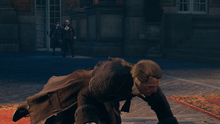
François succumbing to his wounds
In the evening, members of the two sides of the Templar Order gathered at the Palace of Versailles for the induction of Élise de la Serre, daughter of François de la Serre. It was here that Germain launched his coup against François. Sivert and the Roi des Thunes lured François into the palace gardens, murdered him, and incidentally framed Arno Dorian for his death when they escaped just as he arrived at the scene moments before the guards.[3]
Despite Germain's ascendance as Grand Master, he was still opposed by the moderates, supporters of François who were led by Élise, who now craved revenge. At the Estates-General, Germain recruited Frédéric Rouille, a young guard who was passionate for revolutionary ideas but was spurned by his idol Mirabeau. On 5 October, the radical Templars attempted to make the Women's March on Versailles more violent and kill Théroigne de Méricourt, but the Assassins protected the crowd.[3] On the same day, they ambushed Élise and her followers when they met at the Hôtel de Lauzun. The old guard members were killed, except Élise, who jumped in the Seine to escape. After this event, the last allies of Élise were either defected to Germain's faction or purged.[12]
In January 1791, Sivert began to extort money from nobles and members of the clergy as a means to fund Germain's operations. Sivert, however, was killed by Arno Dorian at the Notre-Dame Cathedral. A few days later, Arno assassinated the Roi des Thunes and learned that François' murders had a connection with a silversmith named Germain.

Lafrenière ordering the attack on the Hôtel de Beauvais
On 31 March, Arno investigated Germain's workshop and found the silversmith, not knowing that he was the new Grand Master. With subtle manipulation, Germain led Arno to believe that Lafrenière, who was the last support of Élise, had been behind François's murder, and that he had been imprisoned at his residence for several months by Lafrenière's men. The Assassin subsequently killed Lafrenière while he was amassing his own forces to launch an assault on Germain's followers later that night.[3]
Thus, the radical Templars met at Hôtel de Beauvais later that evening safe from attack, where they organized the last steps of their plan to overthrow the French monarchy and to publicly condemn and execute the king. Marie Lévesque was to hoard the food to trigger a famine; through starvation, the desperate population would become frenzied and violent towards the royal family. Rouille was to prove that the king collaborated with the Austrians to jeopardize the revolution, and le Peletier was to ensure that the National Assembly condemned Louis XVI to death. In the meantime, la Touche informed them of Lafrenière's demise; in disarray, the remaining members of the moderate faction would be wiped out, leaving Élise as the sole survivor. Arno, eavesdropping on the meeting, learned that Germain planned to kill Élise the next day in another ambush. Shortly after, the Templars became alerted to his presence but failed to prevent his escape. The next day, the Assassin saved Élise and together they decided to join their forces against Germain.[3]
Taking over France
On 10 August 1792, after a year of hoarding, the people of Paris rioted against the royal family and stormed the Tuileries Palace. Rouille went to the king's bureau to find the documents that proved not only Louis XVI's alliance with the Austrians but also his correspondence with the late Assassin Mentor Mirabeau. The public, hailing Mirabeau as a great hero of the revolution, would come to see him as a traitor to their cause should his negotiations with the king be exposed. Once again, Arno intervened, burning Mirabeau's letters before Rouille could take them.
On 2 September, Rouille participated in the September Massacres at the Grand Châtelet. Arno, who continued his investigation without the permission of the Council, killed Rouille. During the summer of that year, Théroigne de Méricourt tried to stop the hoarding planned by Flavigny, but she was captured. The Assassins saved her and with her help, killed Flavigny. On 31 October, Marie Lévesque stocked food at the Luxembourg Palace to frame the royal family of the hoarding, but Élise prevented her plot, and Arno assassinated her.
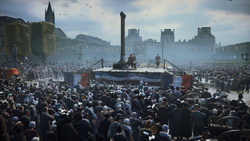
King Louis' execution
Despite the death of notable members of the Templars, Germain succeeded in effecting a death sentence on the king through the tie-breaking vote of Le Peletier at the Legislative Assembly. On 21 January 1793, Germain attended the execution of Louis XVI. Arno, who killed le Peletier, learned that Germain was there and conducted an assassination attempt with Élise. Nevertheless, Germain escaped when his soldiers kept Élise occupied, and Arno refused to leave Élise behind to pursue him, valuing her safety more than he did on Germain's death.
With the monarchy gone, it was replaced by the Republic of France, a new regime where Maximilien de Robespierre, as one of its leading politicians, could begin the Templar's widespread purge. In June, the Templar puppet François Hanriot led an insurrection of Sans-culottes that targeted the Girondists for their Reign of Terror. The Assassins rescued them and helped them to leave the city by boat.
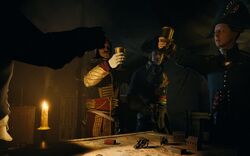
Marcourt and his conspirators preparing the coup
A month later, the Templar General Marcourt and fellow Templars planned a coup d'état in order to accelerate the revolution, but one of the conspirators, Thomas-Alexandre Dumas, was in fact an ally of the Assassins and informed the Brotherhood of Marcourt's plot. Marcourt organized a tournament for recruiting men for the coup. A team of Assassins infiltrated the tournament to approach Marcourt and killed him and his conspirators at the Invalides.[3]
Reign of Terror
In September, Germain and Maximilien de Robespierre initiated the bloodiest period of the revolution, a period of mass purges of all opposition that would go down in history as the Reign of Terror, which they thought essential for the "Great Work". Germain believed that with the horrors of the resulting anarchy, the people would once again submit themselves to a higher power rather than to themselves. Simultaneously, he hoped to eradicate the country of all elements he saw as an incurable ills, to "purify" France as he thought he did the Templars.
In November, one of Robespierre's spies, Didier Paton, discovered the Templar Order and revealed it to his master, Robespierre, not realizing that he was also a Templar. Paton was arrested on charges of treason and condemned to death. The Assassins recovered his notebook where many key Templars were listed and rescued Paton, who joined the Brotherhood shortly afterward.
Later in February 1794, the Templars planned to use Jacques Roux and his Enragés to seize Paris and create chaos. A first team of Assassin was sent to kill Roux, who was imprisoned at the Salpêtrière Hospital, but they failed and were imprisoned in the asylum. A second team of Assassins rescued the first team and succeeded in killing Roux.
On 5 April, after the opposition of Danton and other Indulgents, Robespierre sent his long-time friend and ally to the guillotine for treason along with Danton's allies. Though the Assassins were able to save many of Danton's followers, they stopped short of rescuing Danton himself when he asked that they allow him to be executed, believing that his martyrdom would expose Robespierre's madness.
In May, letters between Mirabeau and Louis XVI were published even though Arno had disposed of some copies of them previously. After learning of his relations with the king, the devastated Parisian revolutionaries, believing them to have been deceived by their exalted hero, rioted for the removal of Mirabeau's ashes from the Panthéon. The Templars tried to retrieve the ashes along with other Assassin secrets, but the Assassins arrived first and successfully transferred them to a safer location[3]
Collapse
In July, La Touche was personally conducting the Reign of Terror in Versailles, presiding over numerous executions. Arno, after spending a period wallowing in depression from his expulsion from the Brotherhood and his argument with Élise, killed him by posing as a prisoner. On 4 June, Robespierre began to lose the popular opinion as he verged closer and closer to establishing a dictatorship and went as far as to host a festival to his personal, newly-devised religion: the Cult of the Supreme Being. At this festival, Élise drugged him so that he looked even more like a mad man during his speech while Arno leaked lists of deputies written by Robespierre to the crowd. Many surviving deputies now believed that they were to be targeted by Robespierre's purges next.
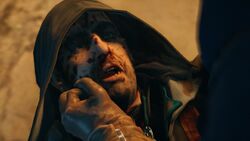
Germain's death
Germain let down Robespierre and on 27 July, the National Convention moved to arrest him at the Hôtel de Ville. Arno and Élise interrogated him just before he was captured and learned that Germain was lurking at the Temple. Germain prepared for the confrontation by taking the Sword of Eden hidden by Jacques de Molay's advisor four centuries before. In the ensuing battle, the sword created a powerful explosion that killed Élise and injured Germain. Arno finished him by slowing driving his hidden blade into Germain's throat. In his last moment, he told to Arno that his plan would still succeed even without him for there would be another shepherd to guide mankind.
On 28 July, Robespierre was guillotined and the remaining Templars from the Jacobin Club were killed by the Assassins before they could escape the city via a tunnel system. With the death of the two Grand Masters, the Templars were no more a threat to France. Under the Directory, the Templars tried to infiltrate the Palais Bourbon with the Election but Arno eliminated them. They also wanted to kill a servant of Louis XVII who they mistook for the prince himself, but Arno saved him.[3]
Modern times
One of the Secret Chiefs met Samuel Liddell Mathers, accompanied by the disembodied being of William Robert Woodman in Paris towards the end of the 19th century. The Chief, who wore a ring marked with the Templar insignia, informed Mathers that his Order's partnership with the Hermetic Order of the Golden Dawn had ended.[13]
Abstergo Industries operated a secret laboratory in Paris for the purpose of researching Precursor artifacts and genetic material until it was destroyed in October 2014 by a team of Assassins led by Gavin Banks.[14]
In November, Eric Cooper set up an Assassin headquarters in Paris to help infiltrate a data hub for the Helix, Abstergo Entertainment's upcoming cloud-based game service.[15]
In 2016, following his discovery that the Sword in Abstergo Industries' possession was missing the Heart, Simon Hathaway traveled to Paris and managed to recover it from where he believed Geoffroy Thérage had cast Fleur's ashes all those years ago. He subsequently delivered both the Heart and the Sword to Alan Rikkin.[7]
Members
Formation of the Knight Templars
Persecution of the Templars
- Jacques de Molay (Grand Master; 1292-1312)
- Jacques de Molay's advisor
Hundred Years' War
- Pierre Cauchon
- Jean d'Estivet
- John of Luxembourg
- John II of Alençon
Renaissance
French Revolution
Radical faction
- Arpinon
- Duchesneau
- François-Thomas Germain (Grand Master; 1789-1794)
- Flavigny
- Jean Gilbert
- Marie Lévesque
- Marcourt
- Denis Molinier
- Payen
- Louis-Michel le Peletier
- Maximilien de Robespierre
- Roi des Thunes
- Frédéric Rouille
- Charles Gabriel Sivert
- Aloys la Touche
Moderate faction
- Magdelaine Lévesque
- Marquis de Pimôdan
- Élise de la Serre
- François de la Serre (Grand Master; 1768 -1789)
- Julie de la Serre
- Marquis de Simonon
Allies and puppets
Hundred Years' War
- John, Duke of Bedford (British Rite)
- Alexander VI (Roman Rite)
- Cesare Borgia (Roman Rite)
- Louis XII of France
- Octavian de Valois (Roman Rite)
- Shay Cormac (Colonial Rite)
- Christopher Gist (Colonial Rite)
- Frederick Weatherall (British Rite)
- Jean-Jacques Blaise d'Abbadie
- Pacon
- Perrault
- Jacques Roux
Trivia
- In Assassin's Creed: Rogue, Achilles Davenport has a wall where he collected information on the Parisian Rite. One of the Parisian Templars was named Charlette Lévesque.
References
- ↑ 1.0 1.1 1.2 1.3 Assassin's Creed: Revelations - Abstergo Files Cite error: Invalid
<ref>tag; name "ACR" defined multiple times with different content - ↑ 2.0 2.1 Assassin's Creed: Project Legacy – Maria Amiel Cite error: Invalid
<ref>tag; name "PL" defined multiple times with different content - ↑ 3.00 3.01 3.02 3.03 3.04 3.05 3.06 3.07 3.08 3.09 3.10 3.11 3.12 3.13 3.14 3.15 3.16 3.17 3.18 Assassin's Creed: Unity
- ↑ 4.0 4.1 4.2 4.3 Assassin's Creed: Rogue
- ↑ 5.0 5.1 Assassin's Creed
- ↑ Assassin's Creed: Bloodlines
- ↑ 7.0 7.1 7.2 7.3 Assassin's Creed: Heresy
- ↑ Assassin's Creed Encyclopedia
- ↑ Assassin's Creed: Brotherhood
- ↑ Assassin's Creed: Project Legacy - Contracts
- ↑ 11.0 11.1 11.2 Assassin's Creed: Forsaken
- ↑ 12.0 12.1 12.2 12.3 12.4 12.5 12.6 12.7 Assassin's Creed: Unity novel
- ↑ Assassin's Creed: Project Legacy - Divine Science: Chapter 4 - Frater V.O.V.
- ↑ Assassin's Creed: Syndicate
- ↑ Twitter - AC: Initiates
| |||||||||||||||||||||||||
| ||||||||||||||||||||||||||||||||||
| |||||||||||||||||||||||||||||||


